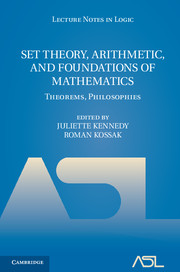Book contents
- Frontmatter
- Contents
- Introduction
- Historical remarks on Suslin's problem
- The continuum hypothesis, the generic-multiverse of sets, and the Ω conjecture
- ω-models of finite set theory
- Tennenbaum's theorem for models of arithmetic
- Hierarchies of subsystems of weak arithmetic
- Diophantine correct open induction
- Tennenbaum's theorem and recursive reducts
- History of constructivism in the 20th century
- A very short history of ultrafinitism
- Sue Toledo's notes of her conversations with Gödel in 1972–5
- Stanley Tennenbaum's Socrates
- Tennenbaum's proof of the irrationality of √2
- References
Historical remarks on Suslin's problem
Published online by Cambridge University Press: 07 October 2011
- Frontmatter
- Contents
- Introduction
- Historical remarks on Suslin's problem
- The continuum hypothesis, the generic-multiverse of sets, and the Ω conjecture
- ω-models of finite set theory
- Tennenbaum's theorem for models of arithmetic
- Hierarchies of subsystems of weak arithmetic
- Diophantine correct open induction
- Tennenbaum's theorem and recursive reducts
- History of constructivism in the 20th century
- A very short history of ultrafinitism
- Sue Toledo's notes of her conversations with Gödel in 1972–5
- Stanley Tennenbaum's Socrates
- Tennenbaum's proof of the irrationality of √2
- References
Summary
The work of Stanley Tennenbaum in set theory was centered on the investigation of Suslin's Hypothesis (SH), to which he made crucial contributions. In 1963 Tennenbaum established the relative consistency of ¬SH, and in 1965, together with Robert Solovay, the relative consistency of SH. In the formative period after Cohen's 1963 discovery of forcing when set theory was transmuting into a modern, sophisticated field of mathematics, this work on SH exhibited the power of forcing for elucidating a classical problem of mathematics and stimulated the development of new methods and areas of investigation.
§ 1 discusses the historical underpinnings of SH. § 2 then describes Tennenbaum's consistency result for ¬SH and related subsequent work. § 3 then turns to Tennenbaum's work with Solovay on SH and the succeeding work on iterated forcing and Martin's Axiom. To cast an amusing sidelight on the life and the times, I relate the following reminiscence of Gerald Sacks from this period, no doubt apocryphal: Tennenbaum let it be known that he had come into a great deal of money, $30,000,000 it was said, and started to borrow money against it. Gerald convinced himself that Tennenbaum seriously believed this, but nonetheless asked Simon Kochen about it. Kochen replied “Well, with Stan he might be one per-cent right. But then, that's still $300,000.”
§1. Suslin's problem. At the end of the first volume of Fundamenta Mathematicae there appeared a list of problems with one attributed to Mikhail Suslin [1920], a problem that would come to be known as Suslin's Problem.
- Type
- Chapter
- Information
- Set Theory, Arithmetic, and Foundations of MathematicsTheorems, Philosophies, pp. 1 - 12Publisher: Cambridge University PressPrint publication year: 2011
References
- 1
- Cited by



